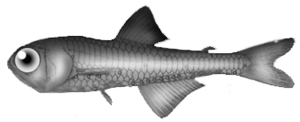Glacier Lanternfish, Benthosema glaciale
Glacier lanternfishes are small (10 cm), with elongate, flattened bodies, and large heads and eyes. Existing mostly in the lightless depths, glacier lanternfish have little need for bright pigmentation and, thus, have dark brown backs and silvery sides. Their fins also lack colour and are all soft-rayed, except the adipose fin, which is fleshy. Their large, heavy scales may provide some protection from predators. Males have a small light organ (photophore) above the caudal fin, while females have two small organs below the caudal fin. These photphores presumably emit flashes of light that may function to attract predators to the tail, allowing the fish to escape. However, the differences between the sexes suggests that the light may also be used in mate location or courtship.
Glacier lanternfishes are found from western Greenland and the Davis Strait, south to the Scotian Shelf. In Atlantic Canada, they are the most common member of the lanternfish family. They prefer waters between 4°C and 16°C, and depths between 146 m and 530 m, with older fish found at greater depths than younger fish. Spawning takes place in the spring or summer. Sexual maturity is reached at 2 years of age and they only live about 4 years, feeding on planktonic crustaceans. Little else is known about the behaviour of this fish

